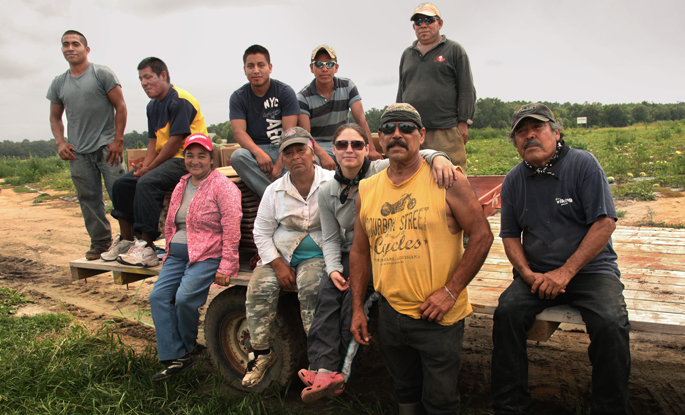The Migrant / Seasonal Farmworker
Definitions and Overview
A migrant farmworker is defined as an individual who is required to be absent from a permanent place of residence for the purpose of seeking remunerated employment in agricultural work. “Migrant farmworkers” are also called “migratory agricultural workers” or “mobile workers”. Seasonal farmworkers are individuals who are employed in temporary farmwork but do not move from their permanent residence to seek farmwork; they may also have other sources of employment.
A migrant farmworker is defined as an individual who is required to be absent from a permanent place of residence for the purpose of seeking remunerated employment in agricultural work. “Migrant farmworkers” are also called “migratory agricultural workers” or “mobile workers”. Seasonal farmworkers are individuals who are employed in temporary farmwork but do not move from their permanent residence to seek farmwork; they may also have other sources of employment.
There is an estimated 2.4 million hired farmworkers in the US, including migrant, seasonal, year-round, and guest program workers.1,2,3
What’s in a name?
The term “migrant farmworker” includes people working temporarily or seasonally in farm fields, orchards, canneries, plant nurseries, fish/seafood packing plants, and more. Guest workers who temporarily live in the US through the federal H-2A program to work on farms are also migrant farmworkers. Other examples of mobile populations beyond migrant farmworkers in the US include people in construction, meatpacking, landscaping, day laborers, and disaster response demolition and clean-up. Migrant Clinicians Network advocates for the health needs of all members of the mobile poor, including migrant farmworkers. “Migrant farmworker,” "migrant agricultural worker," and “migratory agricultural worker” are synonymous.
Accurately assessing demographic information for migrant and seasonal farmworkers is challenging; a mobile lifestyle, limited English proficiency, fear over citizenship status, and other barriers stymie the collection of accurate information. The National Agricultural Workers Survey (NAWS), most recently conducted from 2019 to 2020, gives us some information based on the 2,172 farmworker interviews conducted (which included migrant and seasonal farmworkers, but excluded guest workers).5 NAWS found that 56% of workers surveyed had work authorization, which insinuates that almost half lacked that authorization. The study also found that on average, foreign-born farmworkers interviewed first came to the US 21 years before being interviewed, with just 1% of workers in their first year in the US. Over the course of the NAWS surveys, the average age of an agricultural worker has increased, from 31 in the 1990 survey to 41 in the 2019/2020 survey. Only 16% were migrants, defined by NAWS as people who reported jobs that were at least 75 miles apart or who reported moving more than 75 miles to obtain a farm job the previous year. Much of the workforce was not year-round; respondents spent an average of 39 weeks employed on a farm in the previous year and 22% said they held another non-farmwork job during the previous year.
Learn more about the health needs of this special population on our Migrant Health page. You can also search for relevant resources and clinical tools by keyword in our Resources & Toolbox. Our Archived Webinars feature several free recorded webinars specific to the needs of migrant and seasonal farmworkers.

Worker-related Injuries, Illnesses, and Fatalities
Today, migrant farmworkers still suffer mortality and morbidity rates greater than the majority of the American population, due in part to the combination of poverty, limited access to health care, hazardous working conditions, and the lack of regulations. Agriculture remains one of the most hazardous occupations in the US.In 2021, the fatality rate for agriculture, forestry, fishing and hunting climbed to 19.5 deaths per 100,000 workers, the highest of any industry and drastically higher than the overall average of 3.6 deaths per 100,000 workers. Hispanic workers are more likely than other ethnic groups to be involved in a fatal occupational injury, and recent years’ data have shown increases in fatal work injuries involving Latino workers.4 Farmworkers experience a range of occupational health injuries and illnesses including musculoskeletal strains, lacerations, falls, trauma, exposure to pesticides and other chemicals, heat and cold extremes, and exposure to sun, irritants, and allergens. (Please visit our Environmental and Occupational Health page for more on work injuries in mobile populations.)
Documentation
Many migrant farmworkers have their permanent residence in the US, moving from one location to another during the warmer months, and returning to their homebase in the winter. Every year, more and more workers are given temporary foreign certification through the federal H-2A program, which brings temporary workers into the US for a specified amount of time, after which they return to their country of origin.3, 11 In fiscal year 2021, roughly 258,000 H-2A workers came to the US, up from about 50,000 in 2007. Others attempt an unauthorized crossing of the US-Mexico border, in order to secure seasonal work. Some cross the border seeking asylum, and work at farm jobs while waiting for their immigration hearing.

Health Care Access
All migrant farmworkers who are lawfully present in the US, including H-2A workers, may receive coverage under the Affordable Care Act. Legal farmworkers whose annual income is below 138% of the federal poverty line may receive health care through Medicaid; those above 138% may be eligible for subsidized insurance due to their low incomes, and state-specific policies may expand eligibility.7,8 Because of their temporary status, their employers are not required to provide health insurance by the ACA. Workers who are unauthorized to work in the US cannot receive health insurance through the ACA, and may have difficulty in purchasing private health insurance in the US. (In some states, pregnant women and children without work or living authorization may obtain health care services; see our Women’s Health page for more on prenatal and child health care.) Despite the ACA’s expansion of access to health insurance, farmworker focus groups conducted by Farmworker Justice indicated that farmworkers continue to be unable to access health insurance due to immigration status, affordability, or exemptions for seasonal work under the employer mandates. Many eligible migrant workers found the enrollment process lengthy and complicated, the application itself a barrier for non-citizen applicants. For those who are enrolled in health insurance, high co-pays and deductibles, and lack of familiarity with the US health care system may discourage some agricultural workers from using their health insurance, according to the focus groups.10 Additionally, migratory status can interfere with the ability to remain in care. Read more about the health care barriers of migrant workers on our Migrant Health Overview page. Learn more about MCN’s position on health care access and health justice on our Advancing Health Justice page.
Many community health centers across the country receive funding from the Health Resources and Services Administration (HRSA) Migrant Health Center Program, specifically to care for migrant and seasonal farmworkers. In recent years, HRSA-funded health centers have served almost a million agricultural workers and their families.
The following slideshows illuminate the daily lives of migrant farmworkers associated with the Maine Mobile Health Program, a 501(c)3 nonprofit that provides primary care to farmworkers in Maine through mobile medical units and outreach. The slideshows, entitled “Farmworkers Feed us All,” feature photos by Earl Dotter and audio recordings by Tennessee Watson. Please visit the Maine Mobile Health Program for more information on their programs.
- Maybe It's a Sign
- Farm(work)er
- Reaching Out from Within
- Bury Me with My Rake
- Small Act of Resistance
Resources:
Resources:
1 Martin P, Taylor JE. Ripe with change: Evolving farm labor markets in the United States, Mexico, and Central America. Washington DC: Migration Policy Institute. February 2013. Available at https://www.migrationpolicy.org/sites/default/files/publications/RMSG-Agriculture.pdf. Accessed June 18, 2020.
2 Farm Labor: Background. Economic Research Service. United States Department of Agriculture. https://www.ers.usda.gov/topics/farm-economy/farm-labor/background.aspx#Numbers. Accessed May 5, 2017.
3 2012 Census of Agriculture. United States Summary and State Data, Volume 1. United States Department of Agriculture, May 2014. https://www.agcensus.usda.gov/Publications/2012/Full_Report/Volume_1,_Chapter_1_US/usv1.pdf. Accessed May 5, 2017.
4 Census of Fatal Occupational Injuries (CFOI) - Current and Revised Data. Bureau of Labor Statistics; 2013. http://www.bls.gov/iif/oshcfoi1.htm. Accessed May 5, 2017.
5 United States Department of Labor. (2022). Findings from the National Agricultural Workers Survey (NAWS) 2019-2020: A Demographic and Employment Profile of United States Farmworkers. Research Report No. 16. January 2022. https://www.dol.gov/agencies/eta/national-agricultural-workers-survey/research Accessed 27 April 2023.
6 Mines R et al. Findings from the National Agricultural Workers Survey (NAWS) 1990. A Demographic and Employment Profile of Perishable Crop Farm Workers. Research Report No. 1. https://eric.ed.gov/?id=ED361140
7 Schenker M, McCurdy S et al. Improving the health of agricultural workers and their families in California Current status and policy recommendations. http://www.ucghi.universityofcalifornia.edu/docs/ucghi-ag-work-paper-2015.pdf. Accessed June 25, 2015.
8 2023 Federal Poverty Levels / Guidelines & How They Determine Medicaid Eligibility.
Medicaid Planning Assistance. https://www.medicaidplanningassistance.org/federal-poverty-guidelines/
9 Dunn, TJ. Blockading the border and human rights: The El Paso operation that remade immigration enforcement. Austin, Tex; University of Texas Press: 2009.
10 Guild A. Affordable Care Act: Assessing agricultural worker access to health care. Streamline. 2015;21(3).
11 The H-2A Program in 2022. Rural Migration News. 16 May 2022. https://migration.ucdavis.edu/rmn/blog/post/?id=2720
